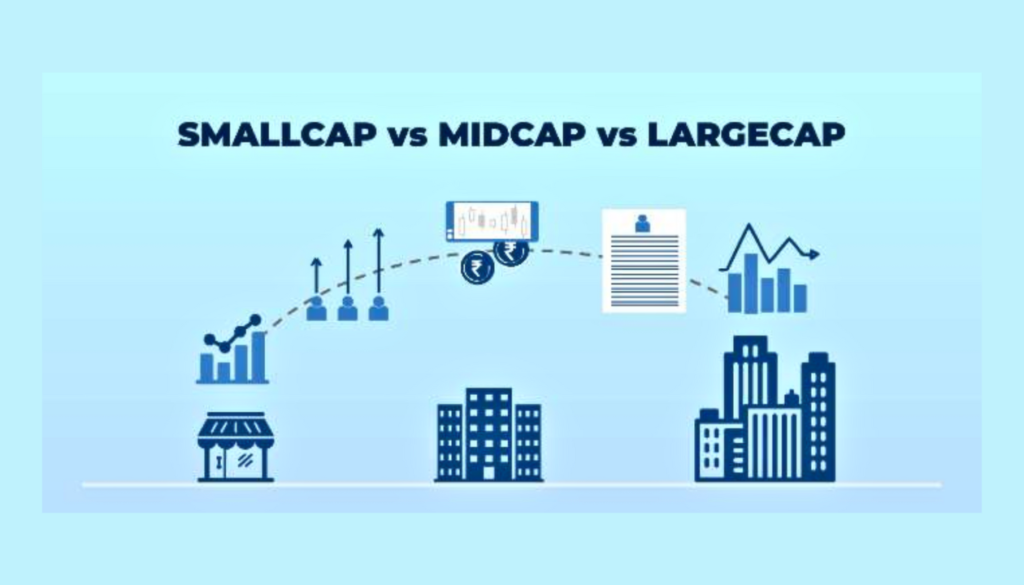Investing in the stock market offers a variety of opportunities, but it’s crucial to understand the different types of stocks and the strategies associated with them. Large cap, Mid cap, and Small cap stocks each have distinct characteristics and investment strategies. This guide will help you understand these categories and how to choose the best strategy for your financial goals.
Table of Contents
1. What Are Large Cap, Mid Cap, and Small Cap Stocks?

A. Large Cap Stocks:
Definition: These are shares of companies with a market capitalization of over ₹10,000 crores (or about $1.5 billion).
Characteristics: Large cap companies are typically well-established, stable, and have a strong market presence. They are often leaders in their industries and offer lower volatility compared to smaller companies.
B. Mid Cap Stocks:
Definition: Mid cap stocks are those of companies with a market capitalization between ₹2,000 crores and ₹10,000 crores (about $250 million to $1.5 billion).
Characteristics: Mid cap companies are generally in the growth phase. They offer a balance between growth potential and stability, making them attractive to investors seeking higher returns with moderate risk.
C. Small Cap Stocks:
Definition: These are shares of companies with a market capitalization of less than ₹2,000 crores (or about $250 million).
Characteristics: Small cap companies are often newer or emerging businesses with high growth potential but also higher volatility. They can offer substantial returns but come with increased risk.
2. Investment Strategies for Different Market Caps

A. Large Cap Investment Strategies:
Stable Growth: Large cap stocks provide stability and steady growth. They are ideal for conservative investors looking for reliable returns with lower risk.
Dividend Income: Many large cap companies pay regular dividends, offering investors a consistent income stream in addition to potential capital gains.
Blue-Chip Stocks: Investing in blue-chip stocks, which are large, reputable companies, can offer long-term stability and growth.
B. Mid Cap Investment Strategies:
Growth Potential: Mid cap stocks are often in a growth phase, offering the potential for substantial returns as they expand and capture market share.
Diversification: Including mid cap stocks in your portfolio can diversify your investments, balancing the stability of large caps with the growth potential of small caps.
Balanced Risk: Mid caps offer a middle ground between the stability of large caps and the high-risk, high-reward nature of small caps. They can be a good choice for investors seeking moderate risk with the potential for significant growth.
C. Small Cap Investment Strategies:
High Growth Opportunities: Small cap stocks have the potential for rapid growth, making them attractive to investors seeking high returns.
Active Management: Due to their volatility, small cap investments may require more active management and research to identify promising opportunities.
Risk Tolerance: Investing in small caps is suitable for those with a higher risk tolerance and a long-term investment horizon, as these stocks can experience significant fluctuations in value.
3. How to Choose the Right Investment Strategy

A. Assess Your Risk Tolerance: Determine how much risk you are willing to take. If you prefer stability, large cap stocks may be more suitable. For higher growth potential with acceptable risk, consider mid cap and small cap stocks.
B. Define Your Investment Goals: Your financial goals will influence your investment choices. If you’re looking for steady income and lower volatility, large caps might be ideal. For higher growth, mid and small caps could be better.
C. Diversify Your Portfolio: A well-diversified portfolio includes a mix of large, mid, and small cap stocks. This balance helps manage risk while aiming for growth.
D. Stay Informed: Regularly review your investments and stay updated on market trends and company performance to make informed decisions.
Conclusion
Understanding the differences between large cap, mid cap, and small cap stocks is essential for developing an effective investment strategy. By aligning your investment choices with your risk tolerance, financial goals, and market conditions, you can build a portfolio that meets your needs and maximize your potential returns. Whether you prefer the stability of large caps, the growth potential of mid caps, or the high-risk, high-reward opportunities of small caps, informed decision-making is key to successful investing.
Frequently Asked Questions
1. What are the main differences between large cap, mid cap, and small cap stocks?
Ans. Large cap stocks are stable and well-established with lower risk; mid cap stocks offer a balance of growth potential and stability; small cap stocks have high growth potential but also higher volatility and risk.
2. How can I determine my risk tolerance for investing in different market caps?
Ans. Assess your financial situation, investment goals, and how comfortable you are with market fluctuations. Higher risk tolerance generally aligns with investing in mid and small cap stocks.
3. Are small cap stocks suitable for long-term investment?
Ans. Yes, small cap stocks can be suitable for long-term investment if you have a high risk tolerance and are prepared for significant short-term fluctuations in value.
4. What are some strategies to reduce risk when investing in mid cap stocks?
Ans. Diversify your investments, research companies thoroughly, and consider a balanced approach by mixing mid caps with large caps to manage overall risk.
5. How often should I review my investment portfolio?
Ans. Regularly review your portfolio, at least quarterly, to ensure it aligns with your investment goals and market conditions. Adjust as needed based on performance and changes in your financial situation.
